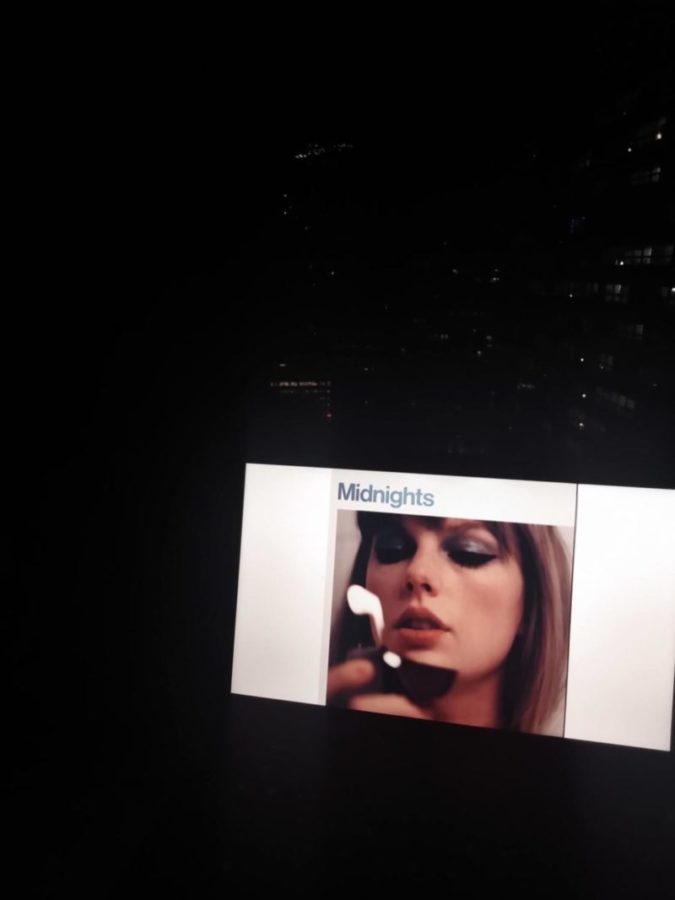Meet Me at ‘Midnight’: A Review of Taylor Swift’s New Album
After a brief period of experimentation with earthy folk music, Taylor Swift has returned to the pop genre for the creation of ‘Midnights,’ but with a twist.
While the main thirteen tracks have been revealed, Taylor Swift has also released seven bonus tracks. Some say that the bonus tracks are far more emotional and align with the mood of songs that she has released in the past.
In the closing track of Midnights, “Mastermind,” the last lyric that Taylor Swift sings is, “Cause I’m a mastermind.” The placement of this line is fitting to express Swift’s limitless talent in her latest album, Midnights. It is a forte that was recognized by many, with fans devouring the albums instantaneously.
Hours after her release, the music-streaming company Spotify announced that Swift’s Midnights had broken two Spotify records, with the “most-streamed album in a single day” and “most-streamed artist in a single day.” Midnights continued to achieve worldwide success, becoming the first album to have all songs reserving a spot in Billboard’s ‘Hot 100.’
Midnights is a complex navigation between finding balance in time, whether or not that may be your past, present, or future. The album is a scattered timeline of events, presenting “thirteen sleepless nights” in Swift’s life, each distinct from one another, but tied tightly together conceptually; although the world has fallen asleep, there are those few, like Swift, who are wide-awake, contemplating deep into the night.
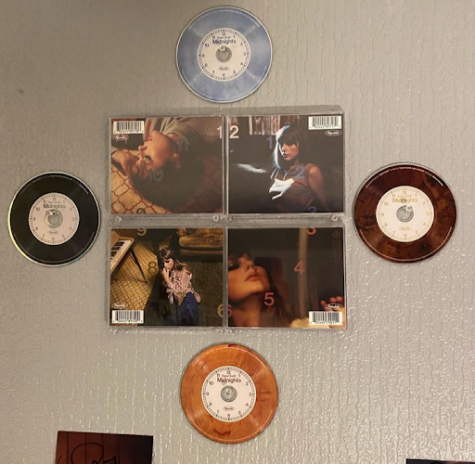
The album takes off with “Lavender Haze,” a song that is similar in sound to the groovy pop music that Taylor Swift is known for. Swift has frequently collaborated with Jack Antonoff, singer, songwriter, and producer, in the past to create albums such as 1989 and Reputation. While these albums were composed of overtly trending pop songs, “Lavender Haze” is uniquely different from the rest, with a subdued and shadowy tone.
Vulture’s John Hull defined the diminished intensity in the musical production of “Lavender Haze” as the Reese-bass, a “synth-bass sound that typically characterizes a low, almost boiling bass patch that adds an air of discomfort to whatever it accompanies.” The Reese-bass along with the whispery vocals produces an overall blurred effect within the song – creating a metaphoric wall between the listener and the song. “Lavender Haze” never truly rises to its pinnacle as a full-fledged dance-pop song, remaining unreachable and distant, much like the rest of the album.
The production aligns with the essence of the song, namely the conflict between being in love and maintaining anonymity within a relationship. In the age of technology, social media has become the third, unspoken member of a relationship, especially if one is as renowned as Taylor Swift. While clarifying the conceptualization behind “Lavender Haze” in an episode of her ‘Midnights Mayhem With Me’ segment, Swift remarks, “And if the world finds out that you’re in love with somebody, they’re gonna weigh in on it.”
Society both forces its outlook on romantic relationships while also apprising what a woman’s place should be in the patriarchy we live in. In Verse II of “Lavender Haze,” Taylor Swift sings, “All they keep asking me / Is if I’m gonna be your bride / The only kinda girl they see / Is a one-night or a wife.” Society does not leave much freedom in its judgments of women. To the world, a woman can resort to becoming a traditional housewife, an option that Swift immediately vetoes, saying she will not partake in “the 1950s [stuff] they want from me.” There is a perpetual emphasis on marriage being the only source of fulfillment for women. If she does not go down that path, society is unforgiving, seeing her as disposable.
In “Vigilante,” Taylor Swift continues her crusade against instituted gender expectations with the bridge: “Ladies always rise above / Ladies know what people want / Someone sweet and kind and fun / The lady simply had enough.” The eerie melody of the bridge emanates a nursery rhyme played in the background of a horror film, adding depth to the lyrics she sings. The character in the song is no longer willing to be coerced into a persona of bubbliness and forced positivity, like the docile wife of the past. Instead, she will play society’s game her own way.
When listening to this song initially, the first thought that comes to mind is how similar it sounds to “I Did Something Bad,” track three of Taylor Swift’s Reputation album from 2017. In “I Did Something Bad,” the background is a heavy beat, blaring and fierce, persisting as the song continues. As a result, there is a general aura of suspense that is maintained throughout. While “Vigilante” has the same theme of suspense and fierceness, it remains stagnant. It never builds to a climactic chorus, prevailing as a plateau of edginess.
Lyrically, “Vigilante” emulates “No Body No Crime,” a song released in Taylor Swift’s Evermore album. Both are byproducts of Swift’s imaginative mind, fictional tales with an aura of mystery that have the narrator interfere in one way or another to achieve justice.
But, the clever genius of Swift does not stop with her storytelling. In fact, it truly takes root in the lead single, “Antihero,” when she exhibits her darkest insecurities to the rest of the world. Taylor Swift proclaimed that “Antihero” is “one of my favorite songs [she has] ever written.” She approached this song as a “a real guided tour throughout all the things [she] tend[s] to hate about [herself].”
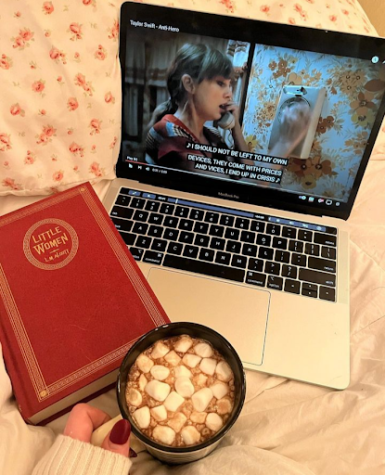
Swift and Antonoff generate an electro-pop type beat, perfect for dancing, but mix it with harsh but honest lyrics. Much of Midnights is a juxtaposition, using mellow and subdued sounds and passionate lyrics. In the chorus that has gone viral since the release of Midnights, Taylor Swift sings brightly, “It’s me / hi! / I’m the problem, / It’s me.” For the first two choruses, her voice is lively, almost as though she is desperately seeking joy in the revelation of her failure.
Later though, in the breakdown before the final chorus, the repetition of “It’s me / hi.. / I’m the problem, / It’s me” is unusual. She sounds out of breath and seemingly exhausted. This particular vocal effect does wonders for the essence of “Antihero;” she thought she could put a brave front against these insecurities of hers but ends up entirely overwhelmed after doing so.
Zachary Hassan, a diehard Swiftie, interpreted the abstractness of “Antihero” further, stating, “[Taylor Swift] says it must be ‘exhausting, rooting for the antihero’ because she always attempts to do better, but ends up making wrong decisions, beating herself up for it. Because of this, she has a hard time believing in herself.”
This feeling of blaming oneself for their missteps resonates with many people, including Faizunnesa Mahzabin ’24, who said, “I think a lot of people are guilty of villainizing themselves, especially in the middle of the night.”
The official music video for “Antihero” added visual context to Swift’s internal state of self. The atmosphere is dim, with the lights turned down low. In her mind, a conscience follows, projecting insecurities onto her, igniting the seed of self-loathing. In one clip, Taylor Swift gazes into the mirror with a long face, drained after weighing herself. Her evil reflection looks back at her with a smirk, recognizing the magnitude of what it has done to her.
But a reflection in the mirror is not the only thing that Swift reflects on in Midnights.
In “Bejeweled,” the narrator is frustrated with a lack of attention from her lover. In an attempt to change the narrative, Swift sings, “And by the way, I’m goin’ out tonight.” It is sung with a fusion of defiance and nonchalance, one that is representative of the song as a whole.
To Maya Giordano ’24, “Bejeweled” is about “her not needing a guy to fulfill her and the fact that they can’t take away her sparkle even if they tried.” Similarly, Riley Thompson ’24 conceptualized “Bejeweled,” as representing, “I really am better than you, so why am I constantly the one pulling for us?”
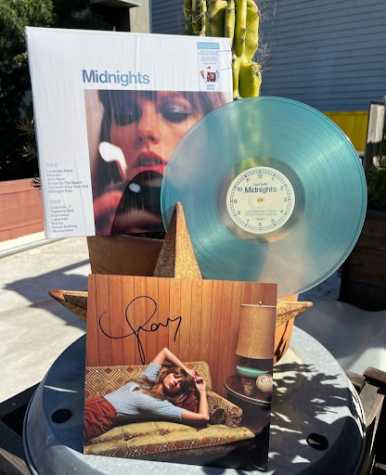
The music video accompanying the song emboldens this message, with a comical retelling of Cinderella. Taylor Swift is dressed lavishly, with costumes embellished in jewels, glittery and glamorous. She performs burlesque in a star-studded bodysuit, embracing an art form that has never been seen before in her music videos. Taylor Swift’s willingness to pay homage by dancing to burlesque is indicative of her openness to trying new things, something that she has done consistently throughout Midnights.
“Bejeweled” is utterly bubble-pop, with a catchy and addictive beat that will leave you swaying. When Swift sings “shimmer” and sparkling” in the song, you can hear her stretching the sound of the last letter, producing a state of wonder. It emphasizes that she truly has the ability to amass the attention of others, without a man beside her. The confidence that she adorns is unlike what we have seen in the past; in this particular moment in her life, Swift has recognized her self-worth, and is certain of her standing, single or not.
However, Taylor Swift does have a partner, Joe Alwyn, whom she has been in a relationship with for over six years. She often draws inspiration from him to integrate into the songs she writes. “Sweet Nothing” is no exception, as Swift delves into a soft ballad, establishing the easy dynamic of her relationship with Alwyn. What makes this ballad so special is that Joe Alwyn, who goes by the alias William Bowery, had actually co-wrote “Sweet Nothing” alongside her. Out of all the tracks on Midnights, Swift’s vocals are heard best in this specific track, simply because the piano and sound effects stay in the background instead of overshadowing her voice, enhancing the melodiousness of it.
Along with this, the message of the song itself is pure: she is truly amazed that he wants nothing from her except her presence in his life. This revelation is a direct instance of her distrust towards people in general, a fact that she has mentioned many times. But, Alwyn is always a soothing balm when Swift reminisces about her painful past. She regards him as an escape, a safety, and a home.
Now, while Midnights itself is a tremendous success, some fans are upset about the only song with a feature: “Snow on the Beach.” Before the release of Midnights, Taylor Swift had announced that Lana Del Rey would be the sole featured artist on her album. As a result, many had formulated the expectation that Del Rey and Swift’s collaboration would be heavenly.
However, it did not quite turn out that way. The song is dreamy and Lana-esque, with glowing imagery when dissecting the act of falling in love. But the song itself did not feature Del Rey with a verse of her own. Instead, she lingered in the background, blending in with Swift’s vocals in the chorus. It made fans wonder what it might’ve been like if Lana Del Rey’s voice had been put in the spotlight just as much as Swift’s. While Del Rey’s vocals may have not been entirely in the mix as we had hoped, her influence stretches all over the song, with the whimsical qualities it contains.
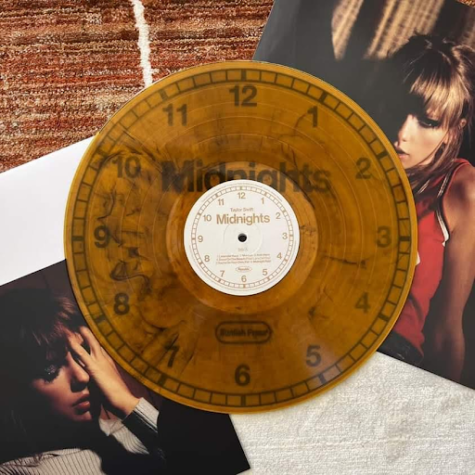
Although Taylor Swift has created a main Midnights album with thirteen undeniably brilliant tracks, she has also released bonus tracks, following a similar method to songs from the vault. In her 3 AM edition, the song that stands out the most is: “Would’ve Could’ve Should’ve.” This track had the potential to be a song on the main album simply because of the sheer emotion it held, lyrically and musically. There was a raw vulnerability that Swift’s voice possessed that could rival even “Antihero.”
“Would’ve Could’ve Should’ve” expresses the immense regret she feels after dating a much older man, at a very young age. You can hear the barely contained emotions in Taylor Swift’s throat, almost as though she is reliving the past all over again. This agonizing feeling only builds when her voice cracks as she belts out, “Give me back my girlhood, it was mine first.” This segment of the song leaves an intense impression on the listener, just as how much the experience has left the artist riddled with everlasting trauma. Swift wishes she could turn back time to undo her past actions, to recover the innocence that she has lost, or had stolen.
It is time that invariably is a chief motif in Midnights. From the timing – midnight – to the lyrics that reference it all throughout the album, it is clear that time is of the essence to Swift. Sometimes she wishes that she could stop time where it is, bask in the moment and stay in it forever. Other moments she hopes for a second chance, to undo what has been done and alleviate regrets. No matter what Taylor Swift’s relation is to time, Midnights has been able to perfectly capture the puzzle that is her life, being relatable to all of us in some way. It makes it worth every second.
To stream Midnights, click here.
Sirajum Munira is a Copy Chief for ‘The Science Survey.’ To her, journalism is a platform to speak truth, and be a voice to the voiceless. Sirajum...

